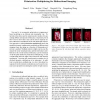Free Online Productivity Tools
i2Speak
i2Symbol
i2OCR
iTex2Img
iWeb2Print
iWeb2Shot
i2Type
iPdf2Split
iPdf2Merge
i2Bopomofo
i2Arabic
i2Style
i2Image
i2PDF
iLatex2Rtf
Sci2ools
89
Voted
CVPR
2005
IEEE
2005
IEEE
Polarization Multiplexing for Bidirectional Imaging
Our goal is to incorporate polarization in appearancebased modeling in an efficient and meaningful way. Polarization has been used in numerous prior studies for separating diffuse and specular reflectance components, but in this work we show that it also can be used to separate surface reflectance contributions from individual light sources. Our approach is called polarization multiplexing and it has significant impact in appearance modeling and bidirectional imaging where the image as a function of illumination direction is needed. Multiple unknown light sources can illuminate the scene simultaneously, and the individual contributions to the overall surface reflectance can be estimated. To develop the method of polarization multiplexing, we use a relationship between light source direction and intensity modulation. Inverting this transformation enables the individual intensity contributions to be estimated. In addition to polarization multiplexing, we show that phase histograms from ...
Computer Vision | CVPR 2005 | Individual Intensity Contributions | Individual Light Sources | Overall Surface Reflectance | Specular Reflectance Components | Surface Reflectance Contributions |
| Added | 12 Oct 2009 |
| Updated | 12 Oct 2009 |
| Type | Conference |
| Year | 2005 |
| Where | CVPR |
| Authors | Oana G. Cula, Kristin J. Dana, Dinesh K. Pai, Dongsheng Wang |
Comments (0)

